Yun Ye
EgoDemoGen: Novel Egocentric Demonstration Generation Enables Viewpoint-Robust Manipulation
Sep 26, 2025


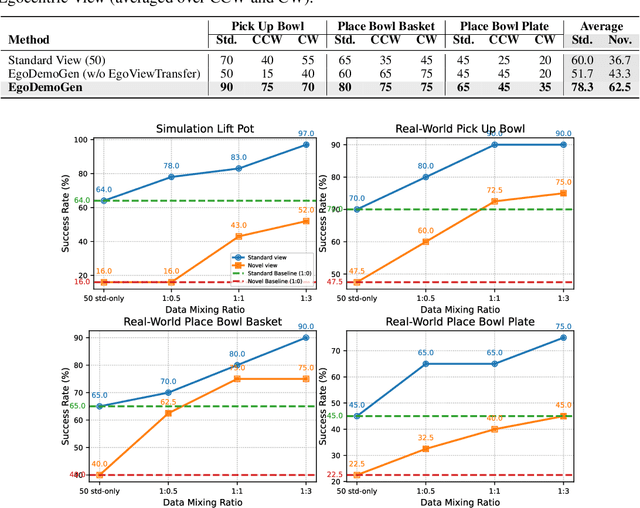
Abstract:Imitation learning based policies perform well in robotic manipulation, but they often degrade under *egocentric viewpoint shifts* when trained from a single egocentric viewpoint. To address this issue, we present **EgoDemoGen**, a framework that generates *paired* novel egocentric demonstrations by retargeting actions in the novel egocentric frame and synthesizing the corresponding egocentric observation videos with proposed generative video repair model **EgoViewTransfer**, which is conditioned by a novel-viewpoint reprojected scene video and a robot-only video rendered from the retargeted joint actions. EgoViewTransfer is finetuned from a pretrained video generation model using self-supervised double reprojection strategy. We evaluate EgoDemoGen on both simulation (RoboTwin2.0) and real-world robot. After training with a mixture of EgoDemoGen-generated novel egocentric demonstrations and original standard egocentric demonstrations, policy success rate improves **absolutely** by **+17.0%** for standard egocentric viewpoint and by **+17.7%** for novel egocentric viewpoints in simulation. On real-world robot, the **absolute** improvements are **+18.3%** and **+25.8%**. Moreover, performance continues to improve as the proportion of EgoDemoGen-generated demonstrations increases, with diminishing returns. These results demonstrate that EgoDemoGen provides a practical route to egocentric viewpoint-robust robotic manipulation.
EMMA: Generalizing Real-World Robot Manipulation via Generative Visual Transfer
Sep 26, 2025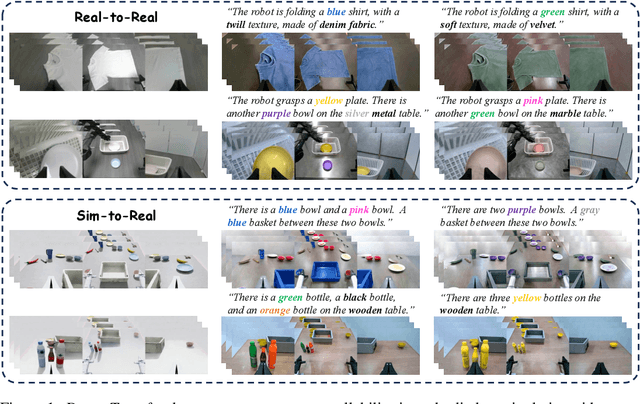
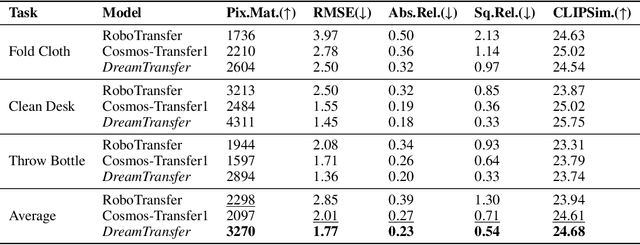


Abstract:Vision-language-action (VLA) models increasingly rely on diverse training data to achieve robust generalization. However, collecting large-scale real-world robot manipulation data across varied object appearances and environmental conditions remains prohibitively time-consuming and expensive. To overcome this bottleneck, we propose Embodied Manipulation Media Adaptation (EMMA), a VLA policy enhancement framework that integrates a generative data engine with an effective training pipeline. We introduce DreamTransfer, a diffusion Transformer-based framework for generating multi-view consistent, geometrically grounded embodied manipulation videos. DreamTransfer enables text-controlled visual editing of robot videos, transforming foreground, background, and lighting conditions without compromising 3D structure or geometrical plausibility. Furthermore, we explore hybrid training with real and generated data, and introduce AdaMix, a hard-sample-aware training strategy that dynamically reweights training batches to focus optimization on perceptually or kinematically challenging samples. Extensive experiments show that videos generated by DreamTransfer significantly outperform prior video generation methods in multi-view consistency, geometric fidelity, and text-conditioning accuracy. Crucially, VLAs trained with generated data enable robots to generalize to unseen object categories and novel visual domains using only demonstrations from a single appearance. In real-world robotic manipulation tasks with zero-shot visual domains, our approach achieves over a 200% relative performance gain compared to training on real data alone, and further improves by 13% with AdaMix, demonstrating its effectiveness in boosting policy generalization.
MimicDreamer: Aligning Human and Robot Demonstrations for Scalable VLA Training
Sep 26, 2025Abstract:Vision Language Action (VLA) models derive their generalization capability from diverse training data, yet collecting embodied robot interaction data remains prohibitively expensive. In contrast, human demonstration videos are far more scalable and cost-efficient to collect, and recent studies confirm their effectiveness in training VLA models. However, a significant domain gap persists between human videos and robot-executed videos, including unstable camera viewpoints, visual discrepancies between human hands and robotic arms, and differences in motion dynamics. To bridge this gap, we propose MimicDreamer, a framework that turns fast, low-cost human demonstrations into robot-usable supervision by jointly aligning vision, viewpoint, and actions to directly support policy training. For visual alignment, we propose H2R Aligner, a video diffusion model that generates high-fidelity robot demonstration videos by transferring motion from human manipulation footage. For viewpoint stabilization, EgoStabilizer is proposed, which canonicalizes egocentric videos via homography and inpaints occlusions and distortions caused by warping. For action alignment, we map human hand trajectories to the robot frame and apply a constrained inverse kinematics solver to produce feasible, low-jitter joint commands with accurate pose tracking. Empirically, VLA models trained purely on our synthesized human-to-robot videos achieve few-shot execution on real robots. Moreover, scaling training with human data significantly boosts performance compared to models trained solely on real robot data; our approach improves the average success rate by 14.7\% across six representative manipulation tasks.
Rethinking Lanes and Points in Complex Scenarios for Monocular 3D Lane Detection
Mar 08, 2025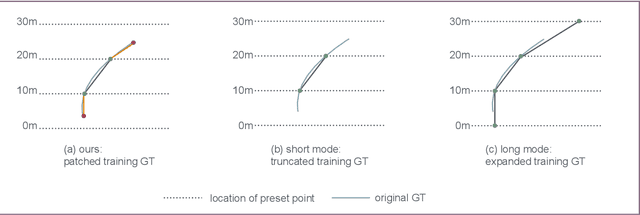
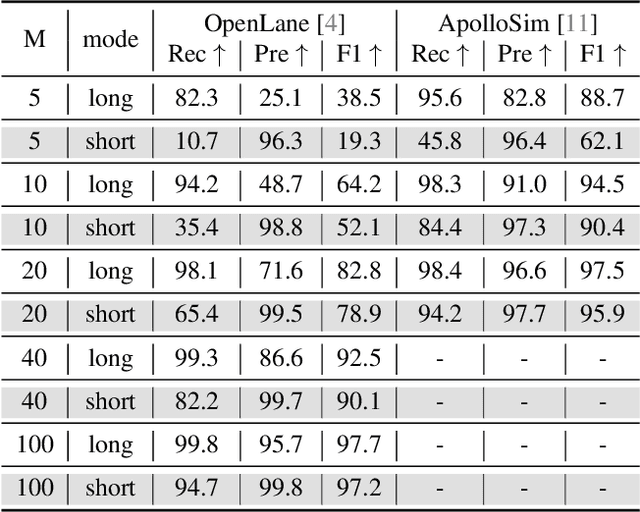
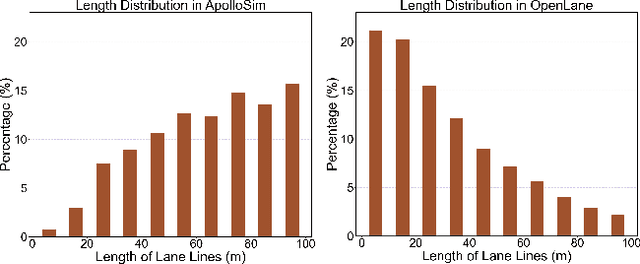

Abstract:Monocular 3D lane detection is a fundamental task in autonomous driving. Although sparse-point methods lower computational load and maintain high accuracy in complex lane geometries, current methods fail to fully leverage the geometric structure of lanes in both lane geometry representations and model design. In lane geometry representations, we present a theoretical analysis alongside experimental validation to verify that current sparse lane representation methods contain inherent flaws, resulting in potential errors of up to 20 m, which raise significant safety concerns for driving. To address this issue, we propose a novel patching strategy to completely represent the full lane structure. To enable existing models to match this strategy, we introduce the EndPoint head (EP-head), which adds a patching distance to endpoints. The EP-head enables the model to predict more complete lane representations even with fewer preset points, effectively addressing existing limitations and paving the way for models that are faster and require fewer parameters in the future. In model design, to enhance the model's perception of lane structures, we propose the PointLane attention (PL-attention), which incorporates prior geometric knowledge into the attention mechanism. Extensive experiments demonstrate the effectiveness of the proposed methods on various state-of-the-art models. For instance, in terms of the overall F1-score, our methods improve Persformer by 4.4 points, Anchor3DLane by 3.2 points, and LATR by 2.8 points. The code will be available soon.
GraphAD: Interaction Scene Graph for End-to-end Autonomous Driving
Apr 07, 2024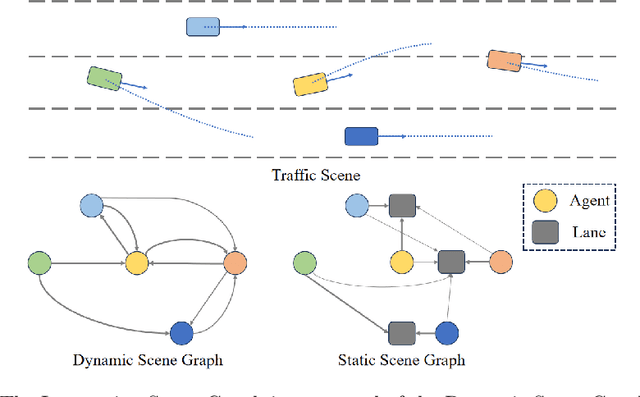
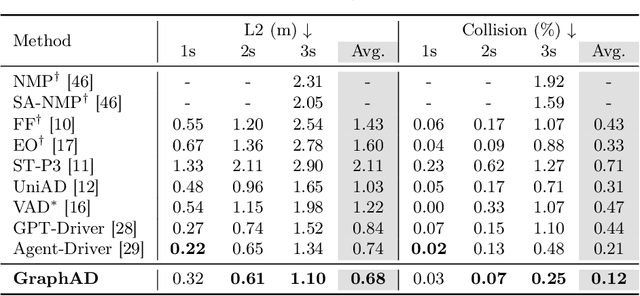
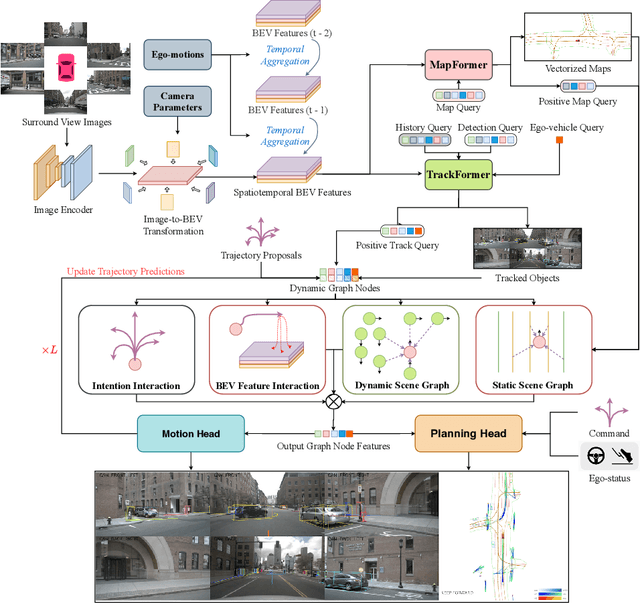
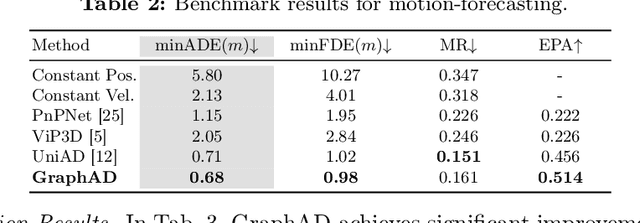
Abstract:Modeling complicated interactions among the ego-vehicle, road agents, and map elements has been a crucial part for safety-critical autonomous driving. Previous works on end-to-end autonomous driving rely on the attention mechanism for handling heterogeneous interactions, which fails to capture the geometric priors and is also computationally intensive. In this paper, we propose the Interaction Scene Graph (ISG) as a unified method to model the interactions among the ego-vehicle, road agents, and map elements. With the representation of the ISG, the driving agents aggregate essential information from the most influential elements, including the road agents with potential collisions and the map elements to follow. Since a mass of unnecessary interactions are omitted, the more efficient scene-graph-based framework is able to focus on indispensable connections and leads to better performance. We evaluate the proposed method for end-to-end autonomous driving on the nuScenes dataset. Compared with strong baselines, our method significantly outperforms in the full-stack driving tasks, including perception, prediction, and planning. Code will be released at https://github.com/zhangyp15/GraphAD.
Detecting As Labeling: Rethinking LiDAR-camera Fusion in 3D Object Detection
Nov 13, 2023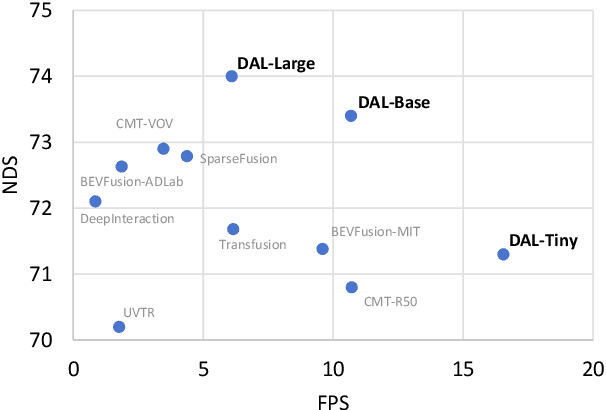

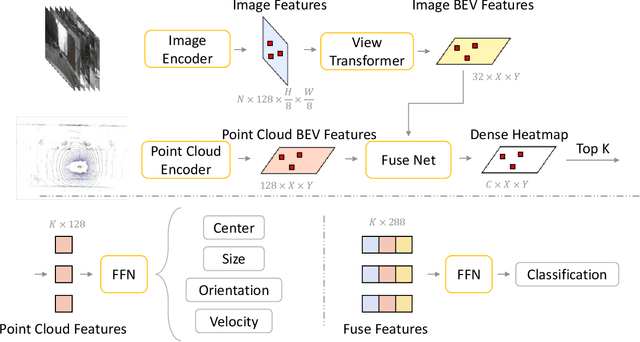
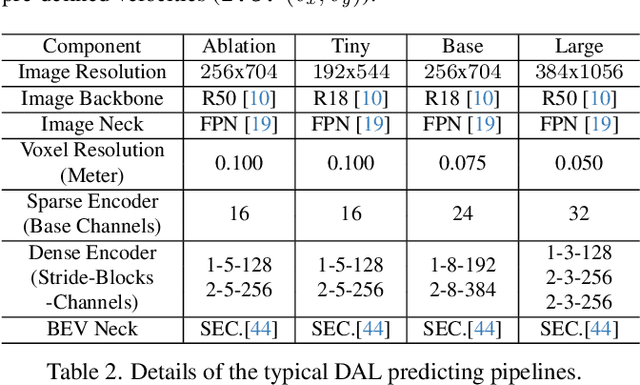
Abstract:3D object Detection with LiDAR-camera encounters overfitting in algorithm development which is derived from the violation of some fundamental rules. We refer to the data annotation in dataset construction for theory complementing and argue that the regression task prediction should not involve the feature from the camera branch. By following the cutting-edge perspective of 'Detecting As Labeling', we propose a novel paradigm dubbed DAL. With the most classical elementary algorithms, a simple predicting pipeline is constructed by imitating the data annotation process. Then we train it in the simplest way to minimize its dependency and strengthen its portability. Though simple in construction and training, the proposed DAL paradigm not only substantially pushes the performance boundary but also provides a superior trade-off between speed and accuracy among all existing methods. With comprehensive superiority, DAL is an ideal baseline for both future work development and practical deployment. The code has been released to facilitate future work on https://github.com/HuangJunJie2017/BEVDet.
CDR-Adapter: Learning Adapters to Dig Out More Transferring Ability for Cross-Domain Recommendation Models
Nov 04, 2023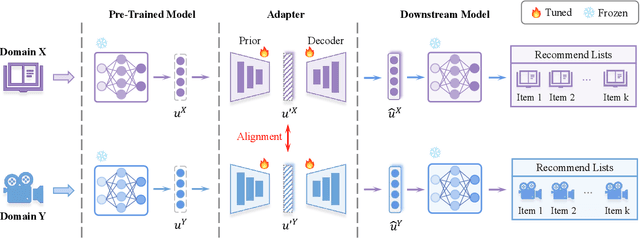

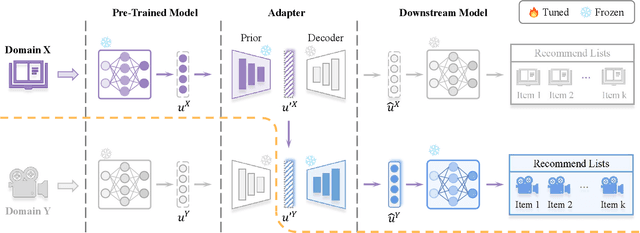
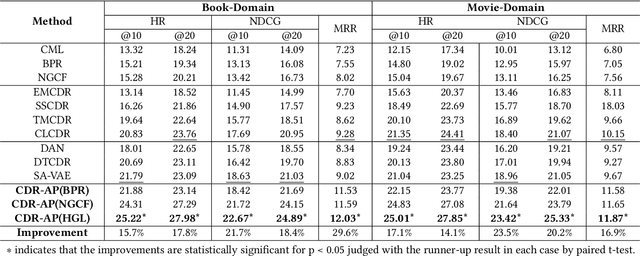
Abstract:Data sparsity and cold-start problems are persistent challenges in recommendation systems. Cross-domain recommendation (CDR) is a promising solution that utilizes knowledge from the source domain to improve the recommendation performance in the target domain. Previous CDR approaches have mainly followed the Embedding and Mapping (EMCDR) framework, which involves learning a mapping function to facilitate knowledge transfer. However, these approaches necessitate re-engineering and re-training the network structure to incorporate transferrable knowledge, which can be computationally expensive and may result in catastrophic forgetting of the original knowledge. In this paper, we present a scalable and efficient paradigm to address data sparsity and cold-start issues in CDR, named CDR-Adapter, by decoupling the original recommendation model from the mapping function, without requiring re-engineering the network structure. Specifically, CDR-Adapter is a novel plug-and-play module that employs adapter modules to align feature representations, allowing for flexible knowledge transfer across different domains and efficient fine-tuning with minimal training costs. We conducted extensive experiments on the benchmark dataset, which demonstrated the effectiveness of our approach over several state-of-the-art CDR approaches.
Frequency-Aware Re-Parameterization for Over-Fitting Based Image Compression
Oct 12, 2023



Abstract:Over-fitting-based image compression requires weights compactness for compression and fast convergence for practical use, posing challenges for deep convolutional neural networks (CNNs) based methods. This paper presents a simple re-parameterization method to train CNNs with reduced weights storage and accelerated convergence. The convolution kernels are re-parameterized as a weighted sum of discrete cosine transform (DCT) kernels enabling direct optimization in the frequency domain. Combined with L1 regularization, the proposed method surpasses vanilla convolutions by achieving a significantly improved rate-distortion with low computational cost. The proposed method is verified with extensive experiments of over-fitting-based image restoration on various datasets, achieving up to -46.12% BD-rate on top of HEIF with only 200 iterations.
DiffBEV: Conditional Diffusion Model for Bird's Eye View Perception
Mar 15, 2023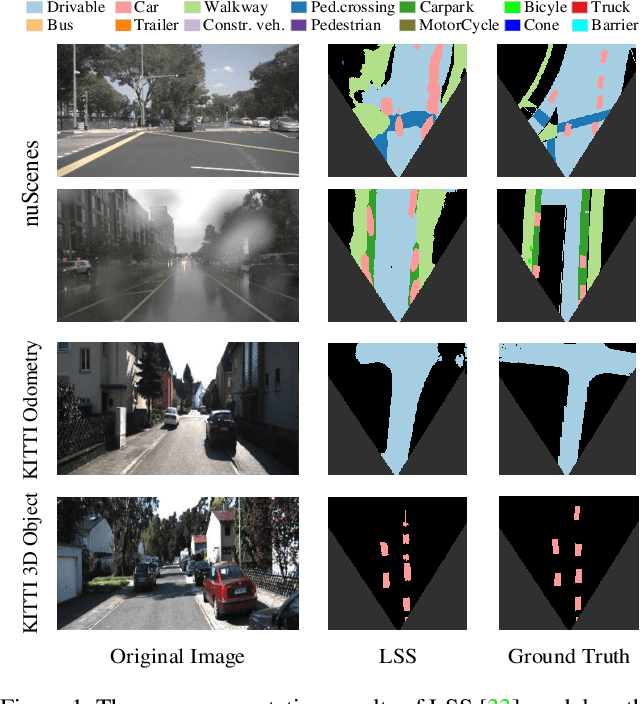
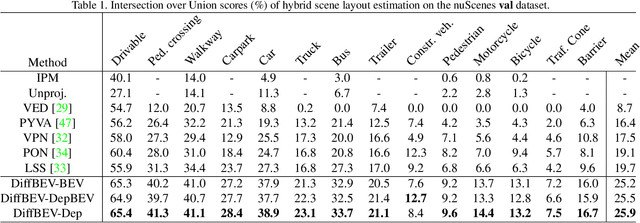
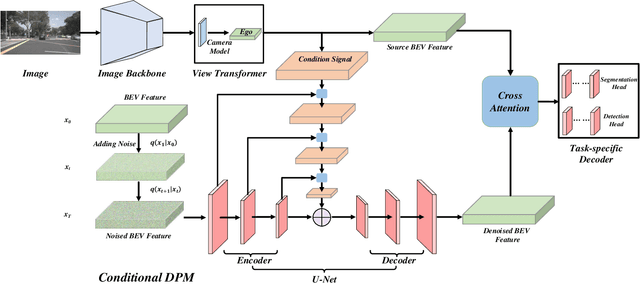
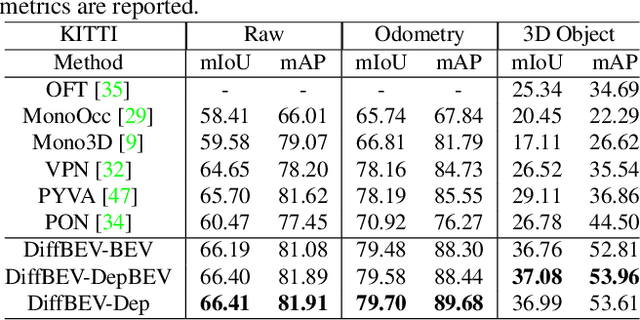
Abstract:BEV perception is of great importance in the field of autonomous driving, serving as the cornerstone of planning, controlling, and motion prediction. The quality of the BEV feature highly affects the performance of BEV perception. However, taking the noises in camera parameters and LiDAR scans into consideration, we usually obtain BEV representation with harmful noises. Diffusion models naturally have the ability to denoise noisy samples to the ideal data, which motivates us to utilize the diffusion model to get a better BEV representation. In this work, we propose an end-to-end framework, named DiffBEV, to exploit the potential of diffusion model to generate a more comprehensive BEV representation. To the best of our knowledge, we are the first to apply diffusion model to BEV perception. In practice, we design three types of conditions to guide the training of the diffusion model which denoises the coarse samples and refines the semantic feature in a progressive way. What's more, a cross-attention module is leveraged to fuse the context of BEV feature and the semantic content of conditional diffusion model. DiffBEV achieves a 25.9% mIoU on the nuScenes dataset, which is 6.2% higher than the best-performing existing approach. Quantitative and qualitative results on multiple benchmarks demonstrate the effectiveness of DiffBEV in BEV semantic segmentation and 3D object detection tasks. The code will be available soon.
OpenOccupancy: A Large Scale Benchmark for Surrounding Semantic Occupancy Perception
Mar 07, 2023
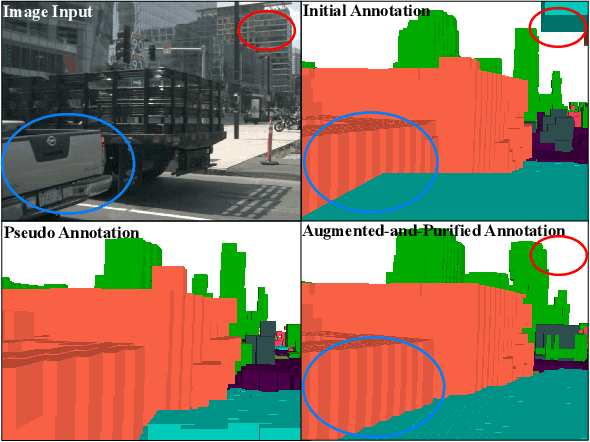
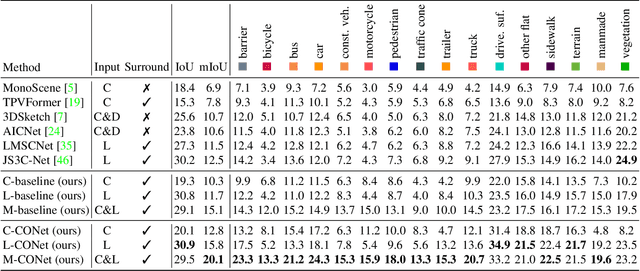
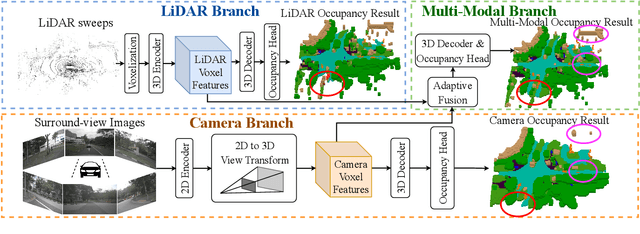
Abstract:Semantic occupancy perception is essential for autonomous driving, as automated vehicles require a fine-grained perception of the 3D urban structures. However, existing relevant benchmarks lack diversity in urban scenes, and they only evaluate front-view predictions. Towards a comprehensive benchmarking of surrounding perception algorithms, we propose OpenOccupancy, which is the first surrounding semantic occupancy perception benchmark. In the OpenOccupancy benchmark, we extend the large-scale nuScenes dataset with dense semantic occupancy annotations. Previous annotations rely on LiDAR points superimposition, where some occupancy labels are missed due to sparse LiDAR channels. To mitigate the problem, we introduce the Augmenting And Purifying (AAP) pipeline to ~2x densify the annotations, where ~4000 human hours are involved in the labeling process. Besides, camera-based, LiDAR-based and multi-modal baselines are established for the OpenOccupancy benchmark. Furthermore, considering the complexity of surrounding occupancy perception lies in the computational burden of high-resolution 3D predictions, we propose the Cascade Occupancy Network (CONet) to refine the coarse prediction, which relatively enhances the performance by ~30% than the baseline. We hope the OpenOccupancy benchmark will boost the development of surrounding occupancy perception algorithms.
 Add to Chrome
Add to Chrome Add to Firefox
Add to Firefox Add to Edge
Add to Edge